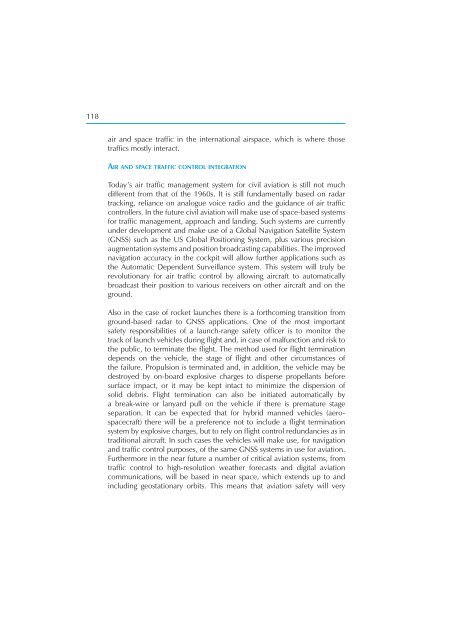Security in Space The Next Generation - UNIDIR
Security in Space The Next Generation - UNIDIR
Security in Space The Next Generation - UNIDIR
You also want an ePaper? Increase the reach of your titles
YUMPU automatically turns print PDFs into web optimized ePapers that Google loves.
118<br />
air and space traffi c <strong>in</strong> the <strong>in</strong>ternational airspace, which is where those<br />
traffi cs mostly <strong>in</strong>teract.<br />
AIR AND SPACE TRAFFIC CONTROL INTEGRATION<br />
Today’s air traffi c management system for civil aviation is still not much<br />
different from that of the 1960s. It is still fundamentally based on radar<br />
track<strong>in</strong>g, reliance on analogue voice radio and the guidance of air traffi c<br />
controllers. In the future civil aviation will make use of space-based systems<br />
for traffi c management, approach and land<strong>in</strong>g. Such systems are currently<br />
under development and make use of a Global Navigation Satellite System<br />
(GNSS) such as the US Global Position<strong>in</strong>g System, plus various precision<br />
augmentation systems and position broadcast<strong>in</strong>g capabilities. <strong>The</strong> improved<br />
navigation accuracy <strong>in</strong> the cockpit will allow further applications such as<br />
the Automatic Dependent Surveillance system. This system will truly be<br />
revolutionary for air traffi c control by allow<strong>in</strong>g aircraft to automatically<br />
broadcast their position to various receivers on other aircraft and on the<br />
ground.<br />
Also <strong>in</strong> the case of rocket launches there is a forthcom<strong>in</strong>g transition from<br />
ground-based radar to GNSS applications. One of the most important<br />
safety responsibilities of a launch-range safety offi cer is to monitor the<br />
track of launch vehicles dur<strong>in</strong>g fl ight and, <strong>in</strong> case of malfunction and risk to<br />
the public, to term<strong>in</strong>ate the fl ight. <strong>The</strong> method used for fl ight term<strong>in</strong>ation<br />
depends on the vehicle, the stage of fl ight and other circumstances of<br />
the failure. Propulsion is term<strong>in</strong>ated and, <strong>in</strong> addition, the vehicle may be<br />
destroyed by on-board explosive charges to disperse propellants before<br />
surface impact, or it may be kept <strong>in</strong>tact to m<strong>in</strong>imize the dispersion of<br />
solid debris. Flight term<strong>in</strong>ation can also be <strong>in</strong>itiated automatically by<br />
a break-wire or lanyard pull on the vehicle if there is premature stage<br />
separation. It can be expected that for hybrid manned vehicles (aerospacecraft)<br />
there will be a preference not to <strong>in</strong>clude a fl ight term<strong>in</strong>ation<br />
system by explosive charges, but to rely on fl ight control redundancies as <strong>in</strong><br />
traditional aircraft. In such cases the vehicles will make use, for navigation<br />
and traffi c control purposes, of the same GNSS systems <strong>in</strong> use for aviation.<br />
Furthermore <strong>in</strong> the near future a number of critical aviation systems, from<br />
traffi c control to high-resolution weather forecasts and digital aviation<br />
communications, will be based <strong>in</strong> near space, which extends up to and<br />
<strong>in</strong>clud<strong>in</strong>g geostationary orbits. This means that aviation safety will very








